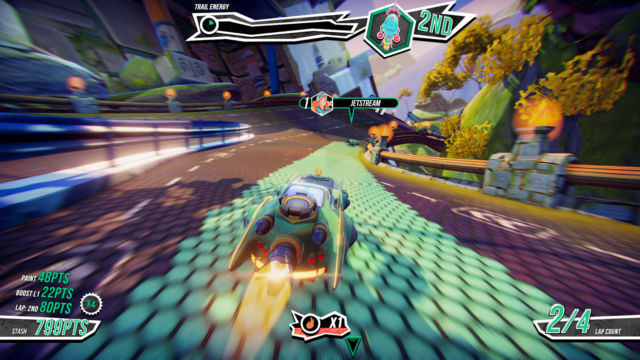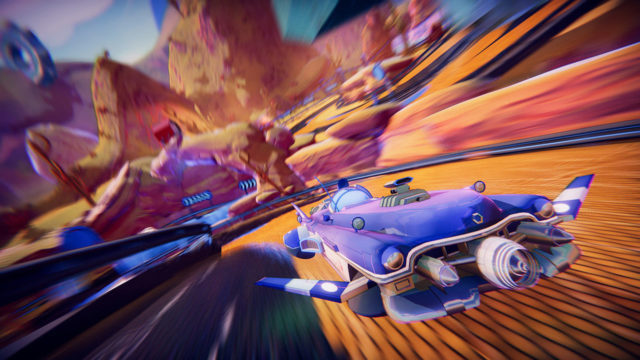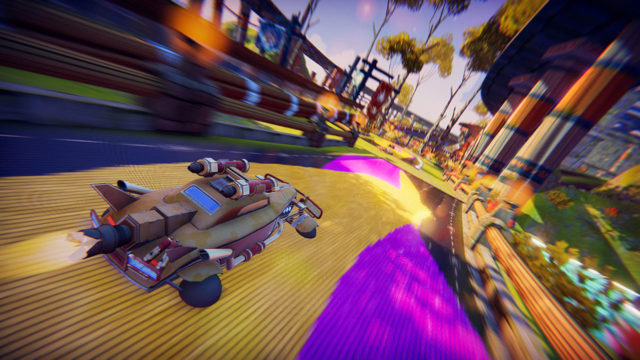Mix of F-Zero and Splatoon sees sci-fi racing coupled with painting the race track; boosting and steering are all smooth; delightful presentation; cool ships
There isn't much to do on these race tracks; mechanics have promise but the execution of them is bland and limited; no easy way to see how the buttons are mapped on the controller
Developer Supergonk aimed high with its concept for Trailblazers. In a nutshell, the game was meant to be an inspired mix of the sci-fi racing elements of series like F-Zero or Wipeout and the painting hijinks of Splatoon. It’s a novel design on paper, but in its execution things start to fall apart. Trailblazers looks pretty and plays smoothly, but in the end fails to do much with its unique concept. The result is a racer that could have stood out from the crowd, but instead is rather forgettable due to dull races and simplistic mechanics.
Racing in Trailblazers is team-based. Rather than going it alone to take the flag at the end, drivers are pushed in the opposite direction and tasked with working together. This is where the game’s painting mechanic comes in. The goal is to use a given racer’s reserve of paint to leave a streak of his team’s color on the track. That streak then becomes a trail for other members of the team to blaze through, gaining a nifty speed boost in the process. Working together, racers can flood a stage with their hue and outrun the competition.
The color streak that the player and teammates leave in their wake is meant to optimize their trip around a given track. Laying down color in all the right spots means that the player’s team is able to more quickly reach the goal, while also acting to impede the opposition. In theory, this is all very cool and largely works during actual gameplay. Once atop a streak of the player’s team’s hue, the driver’s ship automatically begins boosting. However, once the player starts spraying paint, the boosting shuts off, thus demanding some strategizing to know when to leave a trail versus when to take advantage of that extra burst of speed. What’s more, staying within a lane of color for extended periods increases the level of boost, so it’s even more beneficial to link streaks intuitively to gain the highest possible speed.
The paint itself, meanwhile, is available in finite amounts. Once the player’s stores have been emptied, the chamber automatically regenerates after a few seconds. Conversely, players can also choose to use their paint offensively when the need arises by spurting out a streak ahead of the driver’s vehicle which will then stun any opponents caught in the blast. All of this action is facilitated by solid controls. It was a breeze to zip around the track, fire off streams of color onto the road, boost through them, and combat the occasional foe. Yet, as fun as this might sound, there are some serious design pitfalls that Supergonk fell into here which can’t be ignored.
First of all, it’s worth noting that Trailblazers does a poor job of communicating its control scheme. There’s no menu option to simply see which commands are mapped to the buttons on the controller. The player either has to mash buttons to figure out how everything works or again sit through the tutorial stages. It’s a very regrettable and odd omission. It seems that perhaps Supergonk assumed players would intuit on their own that Trailblazers sticks to the now-standard setup of the trigger/shoulder buttons on the controller being used for braking and gas, but that’s a very unwise decision to make. There’s no excuse for not having a basic diagram page devoted to the control setup.

Secondly, races are rather monotonous affairs with little to make them engaging beyond trying to take first place. A big part of the problem is that there’s not much of a sense of speed in Trailblazers, which is odd given the upbeat soundtrack and futuristic race tracks on offer. It’s not that every sci-fi racing game is required to be lightning fast, but Trailblazers gives every impression that the action is going to be snappy, yet in reality it’s disappointingly sedate. Everything runs buttery smooth and looks gorgeous whether docked or in Tabletop mode, but it’s not enough to make up for some lethargic pacing.
Furthermore, Supergonk simply doesn’t take the novel mechanics of painting and boosting anywhere interesting. To compound problems even further, there are multiple examples of simple fixes that could have been made to implement at least a modicum of additional energy to the races. For instance, while part of the goal is to paint over the opposing team’s color streaks, there’s no penalty or impediment caused by coming into contact with the enemy’s hue. The driver’s craft rolls over it as though the opposition’s color trail isn’t even there. While I’ll grant that interruptions to the player’s team’s color streak impedes their boosting, it could have been so much more. It’s emblematic of the overall lack of adversity that makes racing in Trailblazers not beyond an exercise in driving in circles.

Lastly, while there is a cast of characters and crafts to choose from, the former is wholly perfunctory compared to the latter. Outside of maybe Boo (an adorable frog), the drivers in Trailblazers are brutally bland. I can respect that Supergonk wanted to add some personality to Trailblazers through their inclusion, but pitiably their actual personalities are middling at best. I didn’t feel attachment to anyone and honestly glazed over during the story segments (which can mercifully be skipped). The ships themselves, at least, are very cool looking and partly make up for the generic band of racers on offer, but given that none of these crafts are all that fast, Trailblazers quickly becomes a perfect example of being all sizzle and no steak.
There are four modes to partake in:
- Story Mode, which offers a campaign with objective-based races to complete.
- Cup Mode, which provides a handful of typical three-race tournaments to compete in.
- Custom Race, where the rules are all left to the player to determine.
- Online Race, where players can take on real-life racers.

To repeat, Trailblazers‘ problems aren’t technical in nature. There’s a gorgeous aesthetic on display, some nifty looking ships to pilot, plenty of modes to partake in, and all of it is supported with the sort of performance that most other games would kill for. Tragically, this is all for naught as the core conceits of painting and boosting aren’t bolstered by any worthwhile secondary mechanics. Trailblazers is a compilation of gorgeous race tracks with not a lot to do on them. If a sequel ever manages to come about, it’s easy to imagine a version of Trailblazers with better combat, a wider variety of ways to take advantage of painting the track, and more changes/tweaks besides, but until then this is a wasted opportunity on Supergonk’s part. Trailblazers can be fun, but it’s fleeting.
Nintendojo was provided a copy of this game for review by a third party, though that does not affect our recommendation. For every review, Nintendojo uses a standard criteria.




 ShareThis
ShareThis





